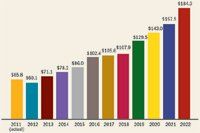Part D private market continues to be an industry hot spot
Part D program exceeds industry expectations

Key Points

Market forces have converged to drive savings, from lower-than-expected enrollment and robust plan competition, to increased use of generics and less overall spending on prescription drugs. While monthly premiums for the Standard Benefit Plan have risen 52% since 2006, according to the Centers for Medicare and Medicaid Services (CMS), they leveled out and actually decreased about 1% between 2011 and 2012.
"Part D is the only benefit program designed with first dollar and catastrophic coverage with a hole in the middle," says Juliette Cubanski, associate director, Program on Medicare Policy for Kaiser Family Foundation (KFF). "Many observers were not expecting a drug-benefit-only program to be adopted so readily by plans."
"Part D also helps seniors stay on drugs even though they may pay 100% in the donut hole-that is less costly than an emergency room or hospital visit," he says.
LOWER ENROLLMENT
According to the Kaiser Family Foundation, several factors are contributing to the gap between the $60 billion in actual spending and the $95 billion CBO projected back in 2003.
At the top of the list is enrollment, which the CBO estimated at 87% of beneficiaries, but in 2012, only 73% have enrolled. Lower enrollment reduced total program costs but has not had a large impact on the spending growth rate since the first year.
Cubanski says she is concerned that some beneficiaries might wait until the need for drug coverage arises-which is difficult to predict-before signing up for Part D, and then would have to pay a late enrollment penalty of 1% of average monthly premiums. The penalty is often considered too weak by critics to be a significant disincentive.
Lujing Wang, practice area leader, pricing and market access for the Campbell Alliance, a management consulting firm, points to additional reasons for Part D success:
"To some extent, these restrictions/cost-management measures are the conditions needed for Part D to continue to exist," Wang says.
COMPETITION AND SPENDING

David Calabrese of OptumRx Talks New Role, Market Insulin Prices and Other Topics 'On His Mind'
April 13th 2023In this month’s episode of the "What's On Your Mind podcast," Peter Wehrwein, managing editor of MHE connects with the now Chief Clinical Officer of OptumRx Integrated Pharmacies, David Calabrese. In this conversation, David touches on his transition in January as OptumRx’s former chief pharmacy officer and market president of health plans and PBMs to his new role as Chief Clinical Officer where he now focuses more on things such as specialty pharmacy to home delivery — with an overall goal of creating whole-patient care. Throughout the conversation, Calabrese also touched on the market’s hot topic of insulin prices and behavioral health services within the OptumRx community, among other topics.
Listen
Briana Contreras, editor of Managed Healthcare Executive, spoke with Nancy Lurker, CEO and president of EyePoint Pharmaceuticals. Nancy shared a bit about EyePoint and how the organization’s innovative therapies are addressing patient needs through eye care, and most importantly, she addressed C-Suite positions like the CEO role. Nancy shared advice for those seeking to reach the CEO level, especially toward women in healthcare and other roles, and what it takes to run a biopharma company.
Listen
Upended: Can PBM Transparency Succeed?
March 6th 2024Simmering tensions in the pharmacy benefit management (PBM) industry have turned into fault lines. The PBMs challenging the "big three" have formed a trade association. Purchaser coalitions want change. The head of the industry's trade group says inherent marketplace friction has spilled over into political friction.
Read More
Florida Gets the OK. But Will Drug Importation from Canada Actually Happen?
March 5th 2024Canadian health officials warn that maintaining a drug supply for Canadians is their priority. The staunch opposition of the U.S. pharmaceutical industry may also be an obstacle to imports from north of the border.
Read More